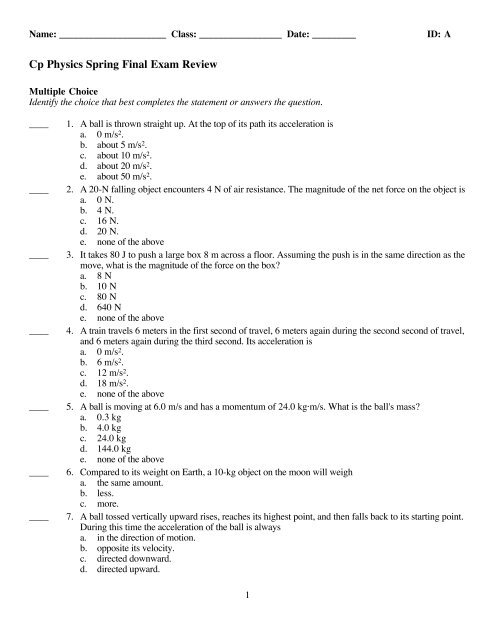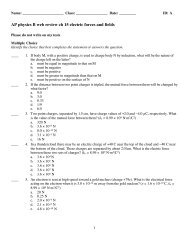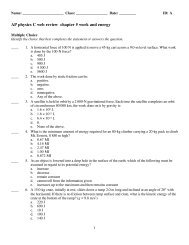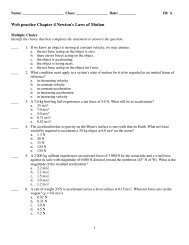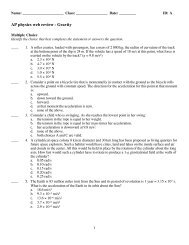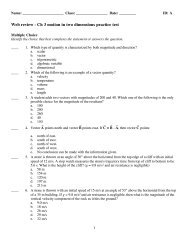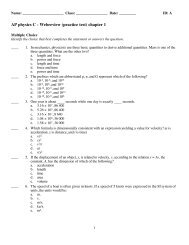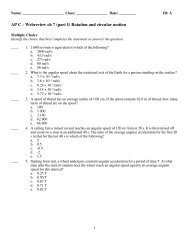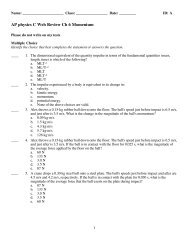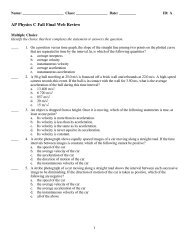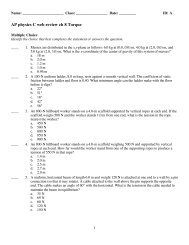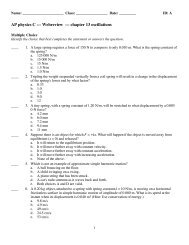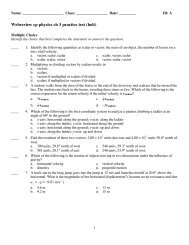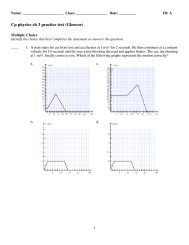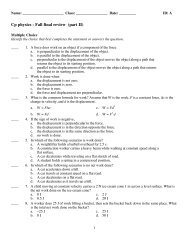Cp Physics Spring Final Exam Review
Cp Physics Spring Final Exam Review
Cp Physics Spring Final Exam Review
- No tags were found...
Create successful ePaper yourself
Turn your PDF publications into a flip-book with our unique Google optimized e-Paper software.
Name: ______________________ Class: _________________ Date: _________<br />
ID: A<br />
<strong>Cp</strong> <strong>Physics</strong> <strong>Spring</strong> <strong>Final</strong> <strong>Exam</strong> <strong>Review</strong><br />
Multiple Choice<br />
Identify the choice that best completes the statement or answers the question.<br />
____<br />
____<br />
____<br />
____<br />
____<br />
____<br />
____<br />
1. A ball is thrown straight up. At the top of its path its acceleration is<br />
a. 0 m/s 2 .<br />
b. about 5 m/s 2 .<br />
c. about 10 m/s 2 .<br />
d. about 20 m/s 2 .<br />
e. about 50 m/s 2 .<br />
2. A 20-N falling object encounters 4 N of air resistance. The magnitude of the net force on the object is<br />
a. 0 N.<br />
b. 4 N.<br />
c. 16 N.<br />
d. 20 N.<br />
e. none of the above<br />
3. It takes 80 J to push a large box 8 m across a floor. Assuming the push is in the same direction as the<br />
move, what is the magnitude of the force on the box?<br />
a. 8 N<br />
b. 10 N<br />
c. 80 N<br />
d. 640 N<br />
e. none of the above<br />
4. A train travels 6 meters in the first second of travel, 6 meters again during the second second of travel,<br />
and 6 meters again during the third second. Its acceleration is<br />
a. 0 m/s 2 .<br />
b. 6 m/s 2 .<br />
c. 12 m/s 2 .<br />
d. 18 m/s 2 .<br />
e. none of the above<br />
5. A ball is moving at 6.0 m/s and has a momentum of 24.0 kg·m/s. What is the ball's mass?<br />
a. 0.3 kg<br />
b. 4.0 kg<br />
c. 24.0 kg<br />
d. 144.0 kg<br />
e. none of the above<br />
6. Compared to its weight on Earth, a 10-kg object on the moon will weigh<br />
a. the same amount.<br />
b. less.<br />
c. more.<br />
7. A ball tossed vertically upward rises, reaches its highest point, and then falls back to its starting point.<br />
During this time the acceleration of the ball is always<br />
a. in the direction of motion.<br />
b. opposite its velocity.<br />
c. directed downward.<br />
d. directed upward.<br />
1
Name: ______________________<br />
ID: A<br />
____ 8. How much power is required to do 40 J of work on an object in 5 seconds?<br />
a. 0 W<br />
b. 5 W<br />
c. 8 W<br />
d. 40 W<br />
e. 200 W<br />
____ 9. A girl whose weight is 500 N hangs from the middle of a bar supported by two vertical strands of<br />
rope. What is the tension in each strand?<br />
a. 0 N.<br />
b. 250 N.<br />
c. 500 N.<br />
d. 750 N.<br />
e. 1000 N.<br />
____ 10. Steam burns are more damaging than burns caused by boiling water because steam<br />
a. is a vapor of water molecules.<br />
b. has a higher temperature than boiling water.<br />
c. has more energy per kilogram than boiling water.<br />
d. occupies more space than water.<br />
e. none of the above<br />
____ 11. A car accelerates at 2 m/s 2 . Assuming the car starts from rest, how much time does it need to<br />
accelerate to a speed of 20 m/s?<br />
a. 2 seconds<br />
b. 10 seconds<br />
c. 20 seconds<br />
d. 40 seconds<br />
e. none of the above<br />
____ 12. Which temperature scale labels the freezing point of water at 0 degrees?<br />
a. Celsius<br />
b. Caloric<br />
c. Kelvin<br />
d. Fahrenheit<br />
e. none of the above<br />
____ 13. A box is dragged without acceleration in a straight-line path across a level surface by a force of 13 N.<br />
What is the frictional force between the box and the surface?<br />
a. 13 N<br />
b. Less than 13 N<br />
c. More than 13 N<br />
d. Need more information to say.<br />
____ 14. If the momentum of an object changes and its mass remains constant,<br />
a. it is accelerating (or decelerating).<br />
b. there is a force acting on it.<br />
c. its velocity is changing.<br />
d. all of the above<br />
e. none of the above<br />
2
Name: ______________________<br />
ID: A<br />
____<br />
____<br />
____<br />
____<br />
____<br />
____<br />
____<br />
15. How much does a 3.0-kg bag of bolts weigh?<br />
a. 7.2 N<br />
b. 14.4 N<br />
c. 22.8 N<br />
d. 29.4 N<br />
e. 58.8 N<br />
16. A 4.0-kg ball has a momentum of 20.0 kg·m/s. What is the ball's speed?<br />
a. 0.2 m/s<br />
b. 5.0 m/s<br />
c. 20.0 m/s<br />
d. 80.0 m/s<br />
e. none of the above<br />
17. The momentum change of an object is equal to the<br />
a. impulse acting on it.<br />
b. velocity change of the object.<br />
c. force acting on it.<br />
d. force acting on it times its velocity.<br />
e. object's mass times the force acting on it.<br />
18. Compared to its mass on Earth, the mass of a 10-kg object on the moon is<br />
a. the same.<br />
b. more.<br />
c. less.<br />
19. Suppose a car is moving in a straight line and steadily increases its speed. It moves from 35 km/h to<br />
40 km/h the first second and from 40 km/h to 45 km/h the next second. What is the car's<br />
acceleration?<br />
a. 5 km/h·s<br />
b. 10 km/h·s<br />
c. 35 km/h·s<br />
d. 40 km/h·s<br />
e. 45 km/h·s<br />
20. A sportscar has a mass of 1500 kg and accelerates at 5 meters per second squared. What is the<br />
magnitude of the force acting on the sportscar?<br />
a. 300 N.<br />
b. 1500 N.<br />
c. 2250 N.<br />
d. 7500 N.<br />
e. none of the above<br />
21. Suppose a girl is standing on a pond where there is no friction between her feet and the ice. In order<br />
to get off the ice, she can<br />
a. bend over touching the ice in front of her and then bring her feet to her hands.<br />
b. walk very slowly on tiptoe.<br />
c. get on her hands and knees and crawl off the ice.<br />
d. throw something in the direction opposite to the way she wants to go.<br />
e. all of the above will work<br />
3
Name: ______________________<br />
ID: A<br />
____<br />
____<br />
____<br />
____<br />
____<br />
____<br />
____<br />
____<br />
22. A 5.0-kg chunk of putty moving at 10.0 m/s collides with and sticks to a 7.0-kg bowling ball that is<br />
initially at rest. The bowling ball with its putty passenger will then be set in motion with a momentum<br />
of<br />
a. 0 kg·m/s.<br />
b. 2.0 kg·m/s.<br />
c. 15.0 kg·m/s.<br />
d. 50.0 kg·m/s.<br />
e. more than 50.0 kg·m/s.<br />
23. A vector is a quantity that has<br />
a. magnitude and time.<br />
b. time and direction.<br />
c. magnitude and direction.<br />
24. A cannon recoils from launching a cannonball. The speed of the cannon's recoil is small because the<br />
a. impulse on the cannon is less than the impulse on the cannonball.<br />
b. cannon has far more mass than the cannonball.<br />
c. momentum of the cannon is unchanged.<br />
d. force against the cannon is relatively small.<br />
e. none of the above<br />
25. Mix a liter of 70°C water with 2 liters of 40°C water and you'll have 3 liters of water at _____.<br />
a. 28°C<br />
b. 50°C<br />
c. 55°C<br />
d. 60°C<br />
26. A book weighs 4 N. When held at rest in your hands, the net force on the book is<br />
a. 0 N.<br />
b. 0.4 N.<br />
c. 4 N.<br />
d. 39 N.<br />
e. none of the above<br />
27. A cannon with a barrel velocity of 140 m/s launches a cannonball horizontally from a tower.<br />
Neglecting air resistance, how far vertically will the cannonball have fallen after 4 seconds?<br />
a. 80 m<br />
b. 140 m<br />
c. 560 m<br />
d. 2240 m<br />
e. none of the above<br />
28. Temperature is related mostly to the _____.<br />
a. average molecular kinetic energy in a substance<br />
b. total kinetic energy in something<br />
c. average energy in a substance<br />
d. total energy in something<br />
e. average kinetic energy of an object<br />
29. A 60-N object moves at 1 m/s. Its kinetic energy is<br />
a. 1 J.<br />
b. 3 J.<br />
c. 60 J.<br />
d. more than 60 J.<br />
4
Name: ______________________<br />
ID: A<br />
____ 30. A car travels in a circle with constant speed. The net force on the car<br />
a. is zero because the car is not accelerating.<br />
b. is directed forward, in the direction of travel.<br />
c. is directed toward the center of the curve.<br />
d. none of the above<br />
____ 31. Suppose a cart is being moved by a force. If suddenly a load is dumped into the cart so that the cart's<br />
mass doubles, what happens to the cart's acceleration?<br />
a. It quarters.<br />
b. It halves.<br />
c. It stays the same.<br />
d. It doubles.<br />
e. It quadruples.<br />
____ 32. Suppose you take a trip that covers 180 km and takes 3 hours to make. Your average speed is<br />
a. 30 km/h.<br />
b. 60 km/h.<br />
c. 180 km/h.<br />
d. 360 km/h.<br />
e. 540 km/h.<br />
____ 33. How many joules of work are done on a box when a force of 25 N pushes it 3 m?<br />
a. 1 J<br />
b. 3 J<br />
c. 8 J<br />
d. 25 J<br />
e. 75 J<br />
____ 34. The mass of a sheep that weighs 110 N is about<br />
a. 1 kg.<br />
b. 11 kg.<br />
c. 110 kg.<br />
d. 1100 kg.<br />
e. none of the above<br />
____ 35. A girl pulls on a 10-kg wagon with a constant force of 20 N. What is the wagon's acceleration?<br />
a. 0.5 m/s 2<br />
b. 2 m/s 2<br />
c. 10 m/s 2<br />
d. 20 m/s 2<br />
e. 200 m/s 2<br />
____ 36. If the force acting on a cart doubles, what happens to the cart's acceleration?<br />
a. It quarters.<br />
b. It halves.<br />
c. It stays the same.<br />
d. It doubles.<br />
e. It quadruples.<br />
5
Name: ______________________<br />
ID: A<br />
____ 37. An object following a straight-line path at constant speed<br />
a. has no forces acting on it.<br />
b. has a net force acting on it in the direction of motion.<br />
c. has zero acceleration.<br />
d. must be moving in a vacuum.<br />
e. none of the above<br />
____ 38. A car starts from rest and after 7 seconds it is moving at 42 m/s. What is the car’s average<br />
acceleration?<br />
a. 0.17 m/s 2<br />
b. 1.67 m/s 2<br />
c. 6 m/s 2<br />
d. 7 m/s 2<br />
e. none of the above<br />
____ 39. The momentum of an object is defined as the object's<br />
a. mass times its velocity.<br />
b. force times the time interval.<br />
c. force times its acceleration.<br />
d. mass times it acceleration.<br />
e. velocity times the time interval.<br />
____ 40. In the absence of air resistance, the angle at which a thrown ball will go the farthest is<br />
a. 15 degrees.<br />
b. 30 degrees.<br />
c. 45 degrees.<br />
d. 60 degrees.<br />
e. 75 degrees.<br />
____ 41. Which has greater kinetic energy, a car traveling at 30 km/h or a half-as-massive car traveling at 60<br />
km/h?<br />
a. The 60 km/h car<br />
b. Both have the same kinetic energy.<br />
c. The 30 km/h car<br />
____ 42. Freezing occurs when matter changes from a<br />
a. solid to a gas.<br />
b. solid to a liquid.<br />
c. gas to a solid.<br />
d. liquid to a gas.<br />
e. liquid to a solid.<br />
____ 43. As a pendulum swings back and forth<br />
a. at the end points of its swing, its energy is all potential.<br />
b. at the lowest part of its swing, its energy is all kinetic.<br />
c. kinetic energy is transformed into potential energy.<br />
d. potential energy is transformed into kinetic energy.<br />
e. all of the above<br />
6
Name: ______________________<br />
ID: A<br />
____<br />
____<br />
____<br />
____<br />
____<br />
____<br />
____<br />
____<br />
44. Accelerations are produced by<br />
a. forces.<br />
b. velocities.<br />
c. accelerations.<br />
d. masses.<br />
e. none of the above<br />
45. Evaporation takes place when matter changes from a<br />
a. solid to a liquid.<br />
b. solid to a gas.<br />
c. liquid to a gas.<br />
d. gas to a liquid.<br />
e. gas to a solid.<br />
46. A 15-N force and a 45-N force act on an object in opposite directions. What is the net force on the<br />
object?<br />
a. 15 N<br />
b. 30 N<br />
c. 45 N<br />
d. 60 N<br />
e. none of the above<br />
47. A person is attracted towards the center of Earth by a 440-N gravitational force. The force with which<br />
Earth is attracted toward the person is<br />
a. 440 N.<br />
b. very very small.<br />
c. very very large.<br />
48. You pull horizontally on a 50-kg crate with a force of 450 N and the friction force on the crate is<br />
250 N. The acceleration of the crate is<br />
a. 2 m/s 2 .<br />
b. 4 m/s 2 .<br />
c. 9 m/s 2 .<br />
d. 14 m/s 2 .<br />
49. A 2-kg ball is thrown at 3 m/s. What is the ball's momentum?<br />
a. 2 kg·m/s<br />
b. 3 kg·m/s<br />
c. 6 kg·m/s<br />
d. 9 kg·m/s<br />
e. none of the above<br />
50. When an iron ring is heated, the hole becomes _____.<br />
a. larger<br />
b. smaller<br />
c. neither smaller nor larger<br />
51. If a projectile is fired straight up at a speed of 30 m/s, the total time to return to its starting point is<br />
about<br />
a. 3 second.<br />
b. 6 seconds.<br />
c. 30 seconds.<br />
d. 60 seconds.<br />
e. not enough information to estimate.<br />
7
Name: ______________________<br />
ID: A<br />
____<br />
____<br />
____<br />
____<br />
____<br />
____<br />
____<br />
____<br />
52. As a ball falls, the action force is the pull of Earth's mass on the ball. What is the reaction to this<br />
force?<br />
a. The pull of the ball's mass on Earth<br />
b. The acceleration of the ball<br />
c. Nonexistent in this case<br />
d. Air resistance acting against the ball<br />
e. none of the above<br />
53. Pressure is defined as<br />
a. time per area.<br />
b. velocity per time.<br />
c. force per time.<br />
d. force per area.<br />
e. distance per time.<br />
54. If the specific heat capacity of water were higher than it is, lakes would be _____.<br />
a. more likely to freeze<br />
b. less likely to freeze<br />
c. neither of the above<br />
55. Condensation occurs when matter changes from a<br />
a. gas to a liquid.<br />
b. solid to a gas.<br />
c. solid to a liquid.<br />
d. liquid to a gas.<br />
e. gas to a solid.<br />
56. How much farther will a car traveling at 100 km/s skid than the same car traveling at 50 km/s?<br />
a. Half as far.<br />
b. The same distance.<br />
c. Twice as far.<br />
d. Four times as far.<br />
e. Five times as far.<br />
57. A rock is thrown vertically into the air. At the very top of its trajectory the net force on it is<br />
a. its weight.<br />
b. less than its weight.<br />
c. more than its weight.<br />
58. A freely falling object starts from rest. After falling for 6 seconds, it will have a speed of about<br />
a. 6 m/s.<br />
b. 30 m/s.<br />
c. 60 m/s.<br />
d. 300 m/s.<br />
e. more than 300 m/s.<br />
59. A player hits a ball with a bat. The action force is the impact of the bat against the ball. What is the<br />
reaction to this force?<br />
a. The force of the ball against the bat<br />
b. The weight of the ball<br />
c. Air resistance on the ball<br />
d. The grip of the player's hand against the bat<br />
e. none of the above<br />
8
Name: ______________________<br />
ID: A<br />
____<br />
____<br />
60. A ball is thrown straight up. At the top of its path its instantaneous speed is<br />
a. 0 m/s.<br />
b. about 5 m/s.<br />
c. about 10 m/s.<br />
d. about 20 m/s.<br />
e. about 50 m/s.<br />
61. Two people pull on a rope in a tug-of-war. Each pulls with 400 N of force. What is the tension in the<br />
rope?<br />
a. 0 N<br />
b. 400 N<br />
c. 600 N<br />
d. 800 N<br />
e. none of the above<br />
9
ID: A<br />
<strong>Cp</strong> <strong>Physics</strong> <strong>Spring</strong> <strong>Final</strong> <strong>Exam</strong> <strong>Review</strong><br />
Answer Section<br />
MULTIPLE CHOICE<br />
1. C<br />
2. C<br />
3. B<br />
4. A<br />
5. B<br />
6. B<br />
7. C<br />
8. C<br />
9. B<br />
10. C<br />
11. B<br />
12. A<br />
13. A<br />
14. D<br />
15. D<br />
16. B<br />
17. A<br />
18. A<br />
19. A<br />
20. D<br />
21. D<br />
22. D<br />
23. C<br />
24. B<br />
25. B<br />
26. A<br />
27. A<br />
28. A<br />
29. B<br />
30. C<br />
31. B<br />
32. B<br />
33. E<br />
34. B<br />
35. B<br />
36. D<br />
37. C<br />
38. C<br />
1
ID: A<br />
39. A<br />
40. C<br />
41. A<br />
42. E<br />
43. E<br />
44. A<br />
45. C<br />
46. B<br />
47. A<br />
48. B<br />
49. C<br />
50. A<br />
51. B<br />
52. A<br />
53. D<br />
54. B<br />
55. A<br />
56. D<br />
57. A<br />
58. C<br />
59. A<br />
60. A<br />
61. B<br />
2


